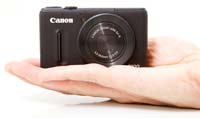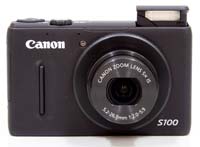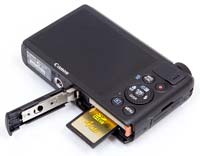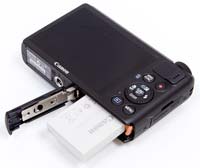 |
| Canon PowerShot S100 |
Info media photography : The Canon PowerShot S100 is a pocket-sized camera that offers a lot of professional features. Aimed at the serious photographer looking for a capable compact, the new Canon S100 features a high-sensitivity 12.1 megapixel 1/1.7-type CMOS sensor, 5x zoom lens with a focal range of 24-140mm and fast maximum aperture of f/2.0, DIGIC 5 processor, and a 3.0 inch LCD display with a resolution of 461K dots, The S100 also offers a maximum ISO of 6400 at full resolution, built-in GPS, 1080p movie recording at 24fps, full range of manual shooting modes, RAW format support and 9.6fps burst shooting. Also present are the innovative lens Control Ring, which enables users to adjust the settings of various functions by twisting the selector at the base of the lens barrel to the left or right, and an anti-shake system which incorporates seven modes of stabilisation. Available in black or silver, the Canon Powershot S100 officially retails for £439.00 / €509.00 / $429.99.
Ease of Use
The new Canon PowerShot S100 is outwardly very similar to the S95 model that it replaces, so some of the comments that we made in that review apply equally to the S100, but there's also a lot of changes that have taken place internally, with a brand new Canon-made image sensor, Digic 5 processor and 5x zoom lens.
The S100 is an understated yet handsome camera that looks a lot simpler than its extensive feature list might suggest. It feels solid at a body-only weight of 198g when gripped in the palm, and measuring 98.9 x 59.8 x 26.7mm it's actually slightly slimmer than its S95 predecessor, impressive given the increase in zoom range, slipping readily into a trouser pocket or handbag. The S100 is completely covered in the same tactile coating as the EOS 7D DSLR, which helps to improve handling, aided by the new small and slim but still useful hand-grip on the front and the rubberised thumb-rest on the rear, two very welcome additions.
Unlike the S95, the S100 increases the megapixel count slightly to a new 12-megapixel sensor, and also changes the sensro type from CCD to CMOS. The S100 now offers the ability to shoot at a maximum ISO speed of 6400 at full stills resolution, with, more unusually still, a plethora of incremental 1/3 stop adjustments available between the lowest ISO 80 setting and this top option.
The S100 also sports a new lens, increasing the zoom range from the S95's 3.8x to a more versatile and wider-angle 5x zoom which offers a focal range of 24-120mm. Canon suggests that its f/2.0 lens has been fitted to allow in twice as much light as a more standard issue f/2.8 aperture optic, allowing for faster shutter speeds and shallower depth of field, although note that it's only f/2.0 at full wide-angle and that the maximum aperture at the 120mm telephoto end is a much slower f/5.9. The optically stabilized 5x zoom provides a four stop advantage and works for both still images and movies, and there's no less than seven different modes of stabilisation (Normal, Panning, Macro, Dynamic, Powered, Dynamic Macro, and Tripod mode) that are automatically detected and applied by the camera.
There's a 3-inch, 461-dot resolution LCD screen, an HDMI (High Definition Multimedia Interface) port for easy hookup to a HDTV set, plus the new Digic 5 processor and exposure adjusting iContrast function now a standard feature across the Canon family. More surprisingly for a compact with a width not a great deal broader than your credit card, both RAW and JPEG capture are also offered.
Perhaps more predictably, point-and-shoot user friendliness on the S100 comes in the form of the fully automatic face detection, motion detection and Smart Auto scene detection technologies regularly found on Canon's snapshot compacts. Something that was missing from the S95 - Full HD video capture - has now been rectified on the S100, with full 1080p movies at 1920x10800 pixels resolution available at 24fps complete with stereo sound. There's also full use of the optical zoom and thankfully continuous auto-focusing too, plus super slow-motion options (640x480 pixels at 120fps or 320x 240 pixels at 240fps), all adding up to a marked improvement on the S95's rather poor video capabilities.
 |
| Rear |
 |
| Front |
In this way, to take one example, users can elect to adjust focus manually, a distance slider appearing on the right hand side of the LCD screen and the central portion of the image enlarged as a further aid to accuracy. Other options for the ring function include changing the aperture, selecting the ISO speed, tweaking of exposure (+/- 2EV), manual adjustment of white balance, as a stepped zoom providing the equivalent of 24mm, 28mm, 35mm, 50mm, 85mm, 100mm and 120mm steps, changing the i-Contrast, or choosing one of the aspect ratios.
Apart from the enticingly tactile draw of the lens ring, the front plate of the S100 houses a stereo microphone within two holes the size of a pinprick to the left of the lens, plus an AF assist/self timer lamp window top left of the lens. The clever flash is housed within the top plate so that when it's raised it is at least a centimeter away from the lens in a cursory attempt to avoid the blight of red eye. Instead of a dedicated button for activating the pop up flash, this is done automatically via selection of the settings offered via the rear command pad/scroll wheel. Select the forced flash option and, technically, rather than popping up, the bulb instead rises majestically from the body with a low mechanical accompaniment… very cool.
Moving to the top plate, we find at its foremost edge a silver shutter release button, which is bigger than the S95's, encircled by a zoom rocker switch with front lip that has been squared off to fall into line with the width of the body and avoid distracting from the clean lines. There's just enough of it to achieve purchase with a fingertip, the lens traveling steadily and surely from maximum wide-angle setting to extreme telephoto in just under three seconds sound-tracked by a low operational whirr.
Also set into the top plate is a small round on/off button. Press this with a fingernail and the S100 powers up for action in just under a second, rear LCD bursting into life soundtracked by a musical 'sting' and the lens barrel extending from its stacked hiding place within the camera's innards to its maximum wide angle setting.
Completing the top of the S100 is the GPS logo, which replaces the S95's Ring Function button (now relocated to the rear). The GPS is set to off as a default and to enable it, you have to go into the main menu, go to Settings and scroll down to the GPS sub menu. It's worth noting that GPS can't be used in every country and if you're travelling abroad, you should check with that country's regulations to make sure you're ok doing it. In practice the GPS system does have a little trouble indoors or under cover, but we found that it worked perfectly outside even with cloud cover, embedding your co-ordinates within the EXIF data. Also the GPS Logger function can record your position at set time intervals so that you can review your journey on the supplied Map Utility software.
 |
| Front |
 |
| Pop-up Flash |
A half press of the nearby shutter button and the camera chooses a point of focus within a quarter of a second, AF point or points flashing in green accompanied by an affirmative 'beep'. Go on to take the shot and there's little if any discernible shutter delay, while full resolution JPEGS are written to inserted (optional) SD or SDHC card (there's no internal memory provided to fall back on) in just over a second, with RAW files - selectable in Program or one of the other four creative shooting modes - taking a mere fraction longer.
With the integral flash housed and hidden to the far left of the top plate (if gazing down on the camera), to the far right is a slightly raised shooting mode dial that's operated by the thumb. Rigid to the touch, it clicks into place at each of its nine mode settings with a definite clicking action. These comprise the creative grouping of Program, Shutter Priority, Aperture Priority, Manual and a single Custom mode, plus separate Smart Auto, Scene, Creative Filters and Movie modes. The new High-speed Burst HQ scene mode allows you to shoot at 9.6fps in an 8-frame burst, although it's JPEG only and there's no manual control. The normal continuous shooting mode offers a still quite impressive shooting rate of 2.3fps. The new Creative Filters shooting mode contains 10 different options, including High Dynamic Range, Miniature and Toy Camera. In the High Dynamic Range mode the S100 combines three separate images to greatly expand the dynamic range.
The S100's Smart Auto functionality goes further than some rivals in comparing common scenes or subjects with not just five or six options, but 32 variables to deliver - in theory - the most appropriate and optimal results. Click the mode wheel around to each subsequent setting and the name and icons of said mode appears on the camera's LCD with, in some cases, a brief text description of the best application for the particular mode. This suggests that the S100 can be used as readily by beginners as more seasoned digital camera users, the variety of shooting options to be found on the mode dial allowing first timers to move beyond their initial comfort zone as familiarity with the camera's workings grows over time. More experienced users can turn this Hints & Tips feature off.
With the back of the Canon S100 largely swallowed up by the high-resolution 3 inch LCD screen, the visibility of which proves more than adequate both indoors and out, a familiar array of controls is found shunted to the right hand side. Familiar, in that they ape those found on the G-series camera's to a fair extent, including the love it or loathe it scroll wheel surrounding the thumb operated four-way control pad.
From the top then is the new rubberised thumb-rest, below we find a pairing of buttons for changing the lens control ring function and a new dedicated one-touch movie record button respectively. The Ring Control button can be more usefully assigned a different function, with no less than 20 different options to choose from. In conjunction with the customisable lens control ring, this makes it easy to tailor the S100 to your own specific way of shooting.
 |
| Memory Card Slot |
 |
| Battery Compartment |
In the centre of the control pad is the Function/Set button. Press this, and as we're used to from recent Canon compacts a toolbar appears down the left hand side of the screen, options highlighted or de-selected dependant on whether the user is in auto capture or one of the more fully featured creative capture modes. In Program mode, for example, selecting the ISO icon provides a slide rule across the bottom of the screen with ISO speeds set out incrementall and the user simply utilizes the scroll wheel or tabs between them to select the desired setting.
The other selectable options on the tool bar comprise white balance (which can now detect scenes with two different light sources and apply area-specific correction in the Smart Auto shooting mode), Canon's familiar 'My Colours' effects modes, an exposure or focus bracketing option - whereby three successive shots are taken - single or continuous shooting modes, self-timer options, switch between evaluative, centre weighted average or spot metering, turn the new neutral density filter on or off to allow for larger apertures in bright conditions, select one of the five aspect ratios, choose the various image capture formats including RAW and/or JPEG, and set the movie size. Finally, the DR Correction option allows you to manually select the DR strength - off, auto, 200% or 400% - and if you want to turn Shadow Correction on.
Returning to the camera back, and below the control pad we find a final pairing of buttons for the self-explanatory Playback and Menu. A press of Menu brings up a trio of folders, for Camera, Setup and My Menu settings, in that order. It's via the first folder that the user can enable such settings as noise reduction, wind filter and auto red eye reduction/removal, as well as blink detection and adjusting the image stabilization mode to come into effect only when taking a shot, when panning the camera, or have it on continuously.
While the left hand flank of the S100, viewed from the rear, is devoid of controls, the right hand side features a hard plastic covered port for both an HDMI cable (not supplied in the box) plus the more regular combined AV out/USB out port (for which two separate cables are provided).
The base of the camera features a metal screw thread for a tripod attachment just left of centre and a sliding door with catch protecting slots for the provided lithium ion rechargeable battery and optional SD/SDHC card, both of which slot relatively easily into place. A battery life lasting 200 shots without flash or 300 minutes of video isn't particular generous however, and any less would be downright alarming at this price point. As it was, after one days' extensive use our battery was back in the provided charger, so you'll want to take this or a spare battery away with you on any extended trip or visit.


0 komentar:
Posting Komentar